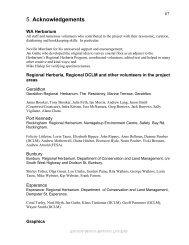Nuytsia 8: 3 (1998) - FloraBase
Nuytsia 8: 3 (1998) - FloraBase
Nuytsia 8: 3 (1998) - FloraBase
Create successful ePaper yourself
Turn your PDF publications into a flip-book with our unique Google optimized e-Paper software.
Paul G. Wilson, Helipterum: Part 1<br />
Annual erect herb, somewhat woolly and with scattered minute globular reddish brown glandular<br />
hairs, single stemmed. Leaves numerous, filiform. Inflorescence a terminal corymb. Capitula homogamous,<br />
shortly pedunculate, radiant. Involucre broadly turbinate c. 5 mm high; bracts c. 4-seriate; outer and<br />
intermediate bracts scarious, sparsely woolly with a thick narrow-oblong stereome; innermost bracts<br />
similar but with a short oblong white limb. Florets 8-12, bisexual; corolla narrow-tubular, slightly broader<br />
above, sparsely glandular puberulous; lobes 5 short, glabrous within, sparsely glandular puberulous<br />
outside, cells of inner epidermis narrow-oblong, vascular strands passing to apex of lobes. Anther<br />
appendage broad-ovate, thick, cells unevenly oblong; anther tails stout, branched, equal to collar. Style<br />
apex truncate, vascular strand thick and extending to just below apex. Achene barrel-shaped with a<br />
truncate apex, moderately hirtellous with slender duplex hairs; carpopodium thick; pericarp crustaceous,<br />
rough; testa papery, free from pericarp, vascular strand passing over apex of seed; vascular strands of<br />
pericarp and of testa in lateral position (in relation to cotyledons). Pappus equal to corolla; bristles<br />
filamentous, shortly plumose, shortly united at base, caducous.<br />
Note. A number of features make this monotypic section unique in the Helichrysum complex; these are:<br />
1) the numerous cauline, lanate, filiform leaves, 2) the short, stout, branched anther tails, and 3) the thick<br />
anther appendage with unevenly shaped oblong cells. Its position in relation to the other sections of<br />
Rhodanthe and to genera in the Casssinia complex is unclear. It is likely that this section should be<br />
recognised as a distinct genus.<br />
Rhodanthe polyphylla (F.Muell.) Paul G. Wilson, comb. nov.<br />
Helipterum polyphyllum F. Muell., Fragm. 1:35(1858). - Argyrocome polyphylla (F. Muell.) Kuntze,<br />
Revis. Gen. Pl. 1:309(1891). Type citation: 'In planitiebus basalticis a fluvio Brisbane usque ad montes<br />
Peak Range. - In tractu Kent’s Plains. W. Hill.’ Lectotype (here chosen): Brisbane River, Peak Range,<br />
F. Mueller (MEL 109740); syntype: Moreton Bay, Kents Plains, anon.(MEL 109757).<br />
Distribution. Eastern Queensland and north-east New South Wales.<br />
Cephalipterum A. Gray<br />
Cephalipterum A. Gray, Hooker’s J. Bot. Kew Gard. Misc. 4:271(1852). Type: Cephalipterum drummondii<br />
A. Gray<br />
Annual erect herb, indumentum of curled filiform hairs septate at base with glandular stipitate<br />
hairs below capitula. Leaves cauline and basal, linear to obovate. Capitula heterogamous, very<br />
shortly pedunculate in dense terminal umbels. Involucre cup-shaped; bracts multiseriate, scarious,<br />
the innermost with a white or yellow lamina. Receptacle small, conical, glabrous. Florets numerous;<br />
1-2 outer bisexual, remainder male. Corolla narrow-urceolate, shortly 5-lobed, glabrous, lobes<br />
smooth within; vascular strands terminating in tube. Anthers: appendix ovate with narrow-oblong<br />
cells; collar short and broadly expanded at base; tails weak; style apex truncate, somewhat broader<br />
than style branch, prominently papillose. Achene broadly compressed obovoid with a broad-circular<br />
apex that has a hard raised lip on the abaxial margin; sterile achenes hard, broad-obovoid, the apical<br />
surface vertical; attachment small, carpopodium absent; indumentum (fertile and sterile achenes) of<br />
dense white clavate helically coiled duplex hairs on abaxial surface, of woolly clawed simple hairs<br />
on adaxial surface; pericarp thick and hard; testa thinly coriaceous closely covered all over with broad-<br />
417




